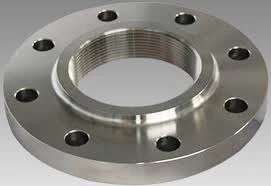What are Threaded Flanges?
Without seam welds, threaded flanges are linked to pipes by screwing the pipe (which has a male thread, commonly NPT per ASME B1.20.1) onto the flange (in certain cases, though, small welds are applied to increase the strength of the connection).
Threaded flanges come in a variety of sizes and pressure ratings up to 4 inches, although they\'re usually utilized in tiny pipelines in low-pressure, low-temperature applications like water and air utility services.
Threaded Flanges are also required in explosive situations, such as petrol stations and plants because welding connections in these environments would be harmful. The bore of a threaded flange is threaded, similar to that of a Slip-On flange. Its main advantage is that it can be put together without welding, which explains why it\'s used in low-pressure applications at normal ambient temperatures and in highly explosive environments where welding would be dangerous.
Uses of Threaded Flanges
Threaded flanges may be connected to pipes of various sizes without the need for welding, which is one of the main reasons for their popularity.
They can be employed in highly high-pressure applications, especially at or near ambient temperatures, where post-weld heat treatment is not viable.
They\'re perfect for pipework with modest diameters.
They are both cost-effective and time-saving gadgets.
Normally, these threaded flanges are used in non-cyclic applications.
The flanges are appropriate for use in situations that need welding.
They can be employed in potentially explosive environments.



